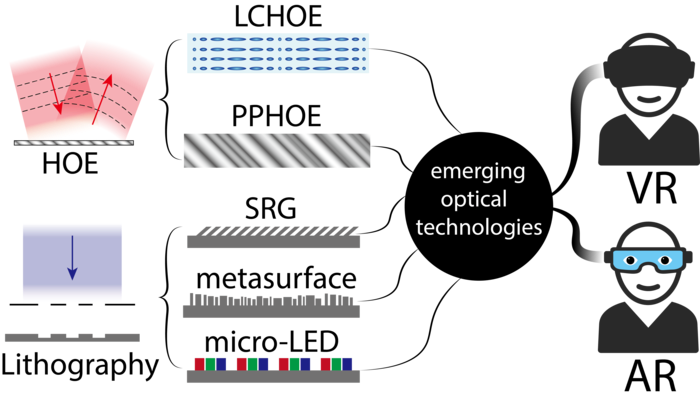Augmented reality (AR) and virtual reality (VR) are generally seen as next-generation displays that can deliver deeper interactions with the digital world than existing flat panel displays. However, it is challenging to gratify the demanding necessities of human vision while keeping a glasses-like form.
 Image Credit: Jianghao Xiong, En-Lin Hsiang, Ziqian He, Tao Zhan, and Shin-Tson Wu
Image Credit: Jianghao Xiong, En-Lin Hsiang, Ziqian He, Tao Zhan, and Shin-Tson Wu
The key reason for this is that the fundamental etendue conservation compromises the field of view and the exit pupil. To boost the system, etendue normally necessitates bulkier optics, which would increase the near-eye display’s weight and size.
However, the latest advances in holographic optical elements (HOEs), metasurface, surface relief grating, and micro light-emitting diodes (micro-LEDs) provide new optical architectures to curtail the etendue limitation.
In a new article reported in Light: Science & Applications, a team of researchers, headed by Prof. Shin-Tson Wu from the College of Optics and Photonics, University of Central Florida, United States, studied the latest progress of HOEs and lithography-assisted devices and their use in AR/VR displays, providing comprehensive descriptions on device working principles, structures, and application in AR/VR headsets.
Another up-and-coming architecture in AR is the Maxwellian-type system. Subject to different operation modes, it can adopt Maxwellian-view, computational holography, and multi-view, all of which are potential contenders to solve the VAC problem in AR.
The big challenge for Maxwellian-type system is the small exit pupil. In the article, the Central Florida researchers appraised several approaches for executing pupil steering and pupil duplication with upcoming HOE technologies.
In the meantime, the light engine in AR is another crucial subject that is repeatedly disregarded in most review articles. Wu’s team compared the workings of numerous types of light engines quantitively, including liquid-crystal-on-silicon, laser beam scanner, and micro-LEDs.
Subsequently, they also summed up the performance of several combiner optics. These hard-to-find data provide a complete understanding of AR system performance with various types of light engines and combiners. In conclusion, the future perceptions of AR/VR display systems are defined.
To decrease the size of optics without compromising the system’s performance, unique folding optical assemblies like pancake optics and waveguide display can be adopted in VR and AR individually.
By implementing thin-film HOEs, pancake optics can be additionally shrunk to the eyeglasses-like formfactor. Furthermore, integrated with dynamic liquid crystal HOE lenses, the knotty vergence-accommodation conflict (VAC) issue can be solved sophisticatedly within a suitable overall system size.
With regard to waveguide architectures, different types of coupler gratings can be implemented, such as volume holographic grating, polarization volume grating, and surface relief grating. Wu’s team offered a comprehensive description of the waveguide design principles with k-diagram and related challenges like diffraction artifacts.
Journal Reference:
Xiong, J., et al. (2021) Augmented reality and virtual reality displays: emerging technologies and future perspectives. Light: Science & Applications. doi.org/10.1038/s41377-021-00658-8.